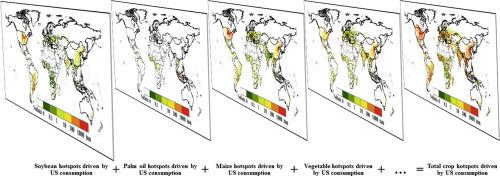Global Food Security ( IF 8.9 ) Pub Date : 2019-10-03 , DOI: 10.1016/j.gfs.2019.09.008 Zhongxiao Sun , Laura Scherer , Arnold Tukker , Paul Behrens

|
International trade plays a critical role in global food security, with global consumption having highly localized environmental impacts. It has been difficult to gain insights into these effects due to the diversity of food production, and complexity of supply chains in international trade. We present a Spatially-explicit Multi-Regional Input-Output (SMRIO) model which couples primary crops and livestock at a high spatial resolution with a global Multi-Regional Input-Output (MRIO) model. We then identify hotspots (the most significant production regions) for primary crops and livestock driven by international consumption. We present the method and data behind this approach, and provide illustrative case studies for Indonesian palm oil and Brazilian soy and beef production. Regionally, China is the largest primary crop consumer, while the EU28 is the largest livestock consumer. Primary crops and livestock hotspots are highly unequal, and the embodied primary crops and livestock for high-income countries are distributed over larger areas when compared to lower-income countries since high-income countries have more numerous trade links. Identified hotspots could allow for increased cooperation between consumers (high-income countries) and producers (lower-income countries) to improve sustainability programs for global food security.


























 京公网安备 11010802027423号
京公网安备 11010802027423号